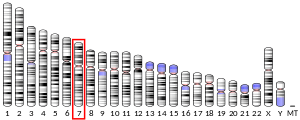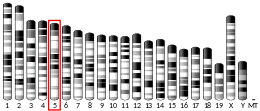ORC5
Origin recognition complex subunit 5 is a protein that in humans is encoded by the ORC5 (ORC5L) gene.[5][6][7]
Function
The origin recognition complex (ORC) is a highly conserved six subunit protein complex essential for the initiation of the DNA replication in eukaryotic cells. Studies in yeast demonstrated that ORC binds specifically to origins of replication and serves as a platform for the assembly of additional initiation factors such as Cdc6 and Mcm proteins. The protein encoded by this gene is a subunit of the ORC complex. It has been shown to form a core complex with ORC2L, -3L, and 4L. Alternatively spliced transcript variants encoding distinct isoforms have been described.[7]
Interactions
ORC5 has been shown to interact with:
gollark: Of course, we foolish mortals will just randomly die after some amount of time anyway, thus upload your mind into the osmarks.tk™ brain emulation network™.
gollark: That's not strictly NEEDED, you won't die as long as all the other conditions are maintained despite your floating.
gollark: You use spotify and not osmarks internet radio™?
gollark: Weaponization of the sun via Nicoll-Dyson beam WHEN?!
gollark: No, you require there to not be too much UV, regardless of how that's provided.
References
- GRCh38: Ensembl release 89: ENSG00000164815 - Ensembl, May 2017
- GRCm38: Ensembl release 89: ENSMUSG00000029012 - Ensembl, May 2017
- "Human PubMed Reference:". National Center for Biotechnology Information, U.S. National Library of Medicine.
- "Mouse PubMed Reference:". National Center for Biotechnology Information, U.S. National Library of Medicine.
- Ishiai M, Dean FB, Okumura K, Abe M, Moon KY, Amin AA, Kagotani K, Taguchi H, Murakami Y, Hanaoka F, O'Donnell M, Hurwitz J, Eki T (Dec 1997). "Isolation of human and fission yeast homologues of the budding yeast origin recognition complex subunit ORC5: human homologue (ORC5L) maps to 7q22". Genomics. 46 (2): 294–8. doi:10.1006/geno.1997.5003. PMID 9417919.
- Tugal T, Zou-Yang XH, Gavin K, Pappin D, Canas B, Kobayashi R, Hunt T, Stillman B (Dec 1998). "The Orc4p and Orc5p subunits of the Xenopus and human origin recognition complex are related to Orc1p and Cdc6p". The Journal of Biological Chemistry. 273 (49): 32421–9. doi:10.1074/jbc.273.49.32421. PMID 9829972.
- "Entrez Gene: ORC5L origin recognition complex, subunit 5-like (yeast)".
- Kneissl M, Pütter V, Szalay AA, Grummt F (Mar 2003). "Interaction and assembly of murine pre-replicative complex proteins in yeast and mouse cells". Journal of Molecular Biology. 327 (1): 111–28. doi:10.1016/s0022-2836(03)00079-2. PMID 12614612.
- Quintana DG, Thome KC, Hou ZH, Ligon AH, Morton CC, Dutta A (Oct 1998). "ORC5L, a new member of the human origin recognition complex, is deleted in uterine leiomyomas and malignant myeloid diseases". The Journal of Biological Chemistry. 273 (42): 27137–45. doi:10.1074/jbc.273.42.27137. PMID 9765232.
- Dhar SK, Delmolino L, Dutta A (Aug 2001). "Architecture of the human origin recognition complex". The Journal of Biological Chemistry. 276 (31): 29067–71. doi:10.1074/jbc.M103078200. PMID 11395502.
- Vashee S, Simancek P, Challberg MD, Kelly TJ (Jul 2001). "Assembly of the human origin recognition complex". The Journal of Biological Chemistry. 276 (28): 26666–73. doi:10.1074/jbc.M102493200. PMID 11323433.
- Pinto S, Quintana DG, Smith P, Mihalek RM, Hou ZH, Boynton S, Jones CJ, Hendricks M, Velinzon K, Wohlschlegel JA, Austin RJ, Lane WS, Tully T, Dutta A (May 1999). "latheo encodes a subunit of the origin recognition complex and disrupts neuronal proliferation and adult olfactory memory when mutant". Neuron. 23 (1): 45–54. doi:10.1016/s0896-6273(00)80752-7. PMID 10402192.
Further reading
- Maruyama K, Sugano S (Jan 1994). "Oligo-capping: a simple method to replace the cap structure of eukaryotic mRNAs with oligoribonucleotides". Gene. 138 (1–2): 171–4. doi:10.1016/0378-1119(94)90802-8. PMID 8125298.
- Klemm RD, Austin RJ, Bell SP (Feb 1997). "Coordinate binding of ATP and origin DNA regulates the ATPase activity of the origin recognition complex". Cell. 88 (4): 493–502. doi:10.1016/S0092-8674(00)81889-9. PMID 9038340.
- Suzuki Y, Yoshitomo-Nakagawa K, Maruyama K, Suyama A, Sugano S (Oct 1997). "Construction and characterization of a full length-enriched and a 5'-end-enriched cDNA library". Gene. 200 (1–2): 149–56. doi:10.1016/S0378-1119(97)00411-3. PMID 9373149.
- Quintana DG, Thome KC, Hou ZH, Ligon AH, Morton CC, Dutta A (Oct 1998). "ORC5L, a new member of the human origin recognition complex, is deleted in uterine leiomyomas and malignant myeloid diseases". The Journal of Biological Chemistry. 273 (42): 27137–45. doi:10.1074/jbc.273.42.27137. PMID 9765232.
- Jiang W, McDonald D, Hope TJ, Hunter T (Oct 1999). "Mammalian Cdc7-Dbf4 protein kinase complex is essential for initiation of DNA replication". The EMBO Journal. 18 (20): 5703–13. doi:10.1093/emboj/18.20.5703. PMC 1171637. PMID 10523313.
- Thome KC, Dhar SK, Quintana DG, Delmolino L, Shahsafaei A, Dutta A (Nov 2000). "Subsets of human origin recognition complex (ORC) subunits are expressed in non-proliferating cells and associate with non-ORC proteins". The Journal of Biological Chemistry. 275 (45): 35233–41. doi:10.1074/jbc.M005765200. PMID 10954718.
- Vashee S, Simancek P, Challberg MD, Kelly TJ (Jul 2001). "Assembly of the human origin recognition complex". The Journal of Biological Chemistry. 276 (28): 26666–73. doi:10.1074/jbc.M102493200. PMID 11323433.
- Fröhling S, Nakabayashi K, Scherer SW, Döhner H, Döhner K (Apr 2001). "Mutation analysis of the origin recognition complex subunit 5 (ORC5L) gene in adult patients with myeloid leukemias exhibiting deletions of chromosome band 7q22". Human Genetics. 108 (4): 304–9. doi:10.1007/s004390100498. PMID 11379876.
- Dhar SK, Delmolino L, Dutta A (Aug 2001). "Architecture of the human origin recognition complex". The Journal of Biological Chemistry. 276 (31): 29067–71. doi:10.1074/jbc.M103078200. PMID 11395502.
- Kneissl M, Pütter V, Szalay AA, Grummt F (Mar 2003). "Interaction and assembly of murine pre-replicative complex proteins in yeast and mouse cells". Journal of Molecular Biology. 327 (1): 111–28. doi:10.1016/S0022-2836(03)00079-2. PMID 12614612.
- Ramachandran N, Hainsworth E, Bhullar B, Eisenstein S, Rosen B, Lau AY, Walter JC, LaBaer J (Jul 2004). "Self-assembling protein microarrays". Science. 305 (5680): 86–90. doi:10.1126/science.1097639. PMID 15232106.
This article is issued from Wikipedia. The text is licensed under Creative Commons - Attribution - Sharealike. Additional terms may apply for the media files.





